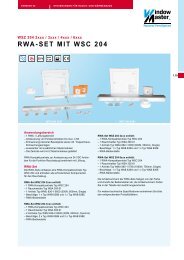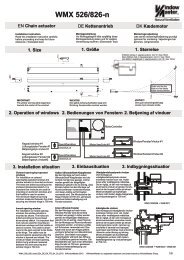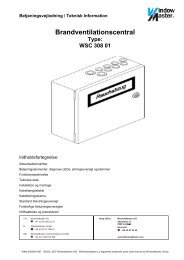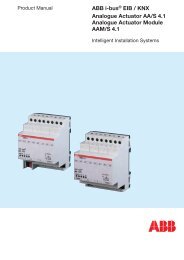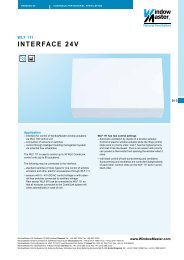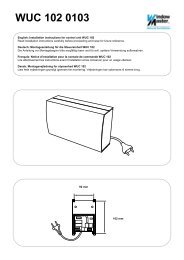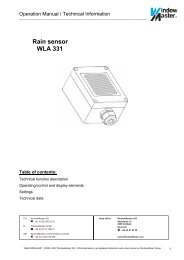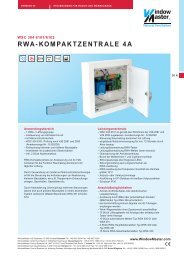ABB i-bus® EIB Universal Interfaces US/U 4.2 US/U ... - WindowMaster
ABB i-bus® EIB Universal Interfaces US/U 4.2 US/U ... - WindowMaster
ABB i-bus® EIB Universal Interfaces US/U 4.2 US/U ... - WindowMaster
You also want an ePaper? Increase the reach of your titles
YUMPU automatically turns print PDFs into web optimized ePapers that Google loves.
<strong>ABB</strong> i-bus ® <strong>EIB</strong><br />
<strong>Universal</strong> <strong>Interfaces</strong><br />
<strong>US</strong>/U 2.2, GH Q631 0074 R0111<br />
<strong>US</strong>/U <strong>4.2</strong>, GH Q631 0070 R0111<br />
Parameter: “Control the scene via”<br />
It is possible to select whether the scene control is carried out via “5 separate<br />
objects” or whether values that are stored in the actuators are recalled and<br />
saved via an “8 bit scene” (see section 5.5 for further information).<br />
Parameter: “Reaction on short operation”<br />
This parameter defines whether a short operation of the input causes<br />
a lightscene to be recalled or no reaction takes place.<br />
Parameter: “Store scene”<br />
This parameter specifies how the saving of the current scene can be triggered<br />
and defines the function of the object “Store scene”. This is dependent on<br />
the type of scene control. The following table provides an overview:<br />
Control the scene via “5 separate objects”<br />
Parameter value<br />
“on long operation”<br />
“if object value = 1”<br />
“on long operation<br />
(if object value = 1)”<br />
Behaviour<br />
As soon as a long operation is detected, the object “Store<br />
scene” sends the value “1” on the bus and the object values<br />
“Telegr. switch/value actuator group A…E” are read out<br />
via the bus and stored in the object values.<br />
The objects “Telegr. switch/value actuator group A…E” can be<br />
modified via the bus for the duration of the long operation.<br />
Once the long operation has finished, the object<br />
“Store scene” sends the value “0” on the bus and the current<br />
object values are stored in the device.<br />
If the object “Store scene” receives the value “1”, the object<br />
values “Telegr. switch/value actuator group A…E” are read out<br />
via the bus.<br />
While the object value is “1”, the objects “Telegr. switch/value<br />
actuator group A…E” can be modified via the bus.<br />
On receipt of the object value “0”, the current object values<br />
are stored in the device.<br />
Important:<br />
The storing of the current scene requires the object values<br />
“1” and “0” to be sent in succession.<br />
If the object “Store scene” receives the value “1” on the bus,<br />
the next long push button action leads to the value “1” being<br />
sent via the object “Store scene”.<br />
The scanning of the object values “Telegr. switch/value actuator<br />
group A…E” is then carried out.<br />
After the end of the long operation, the object values “Telegr.<br />
switch/value actuator group A…E” are stored in the device.<br />
Provided that a “1” has not been received at the object “Store<br />
scene”, a long operation is interpreted in the same way as a<br />
short operation. The same applies if the object “Store scene”<br />
has received the value “0”.<br />
24



